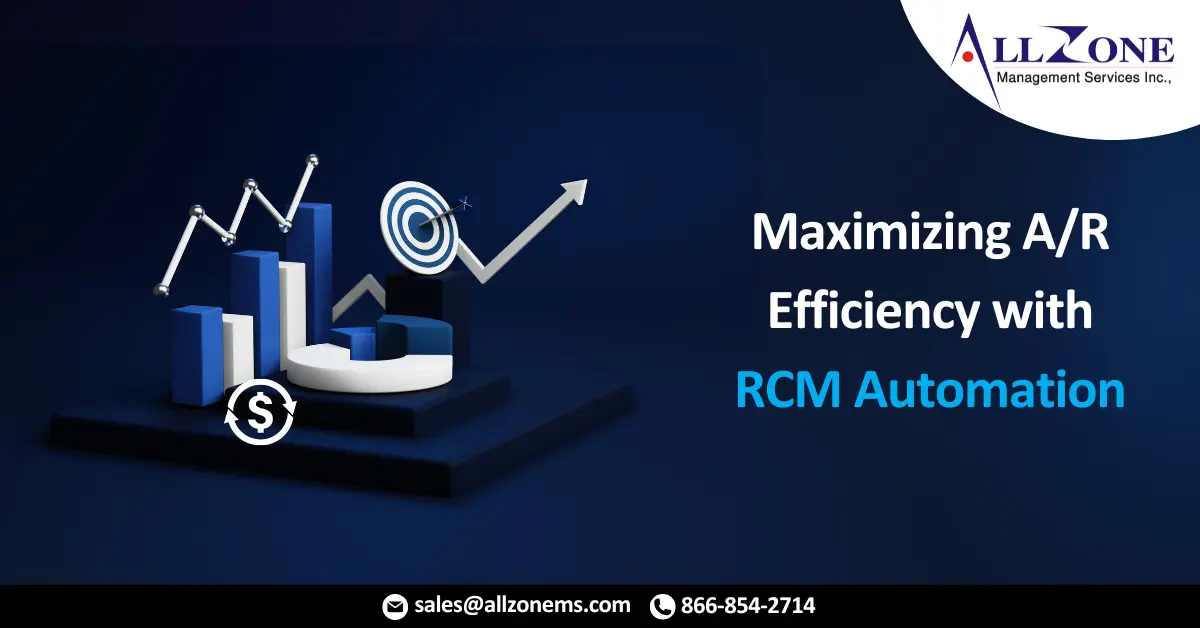A well-managed A/R process ensures timely cash flow, reduces administrative burdens, and maintains the stability of a healthcare practice. However, many healthcare practices still struggle with outdated, manual A/R management processes that can lead to inefficiencies, errors, and delayed payments. In recent years, Revenue Cycle Management (RCM) automation has emerged as a game-changer in addressing these challenges and streamlining A/R operations.
In this blog, we will explore how RCM automation can significantly improve a practice’s A/R efficiency, reduce days in A/R, and enhance the overall revenue cycle.
What is RCM Automation?
Revenue Cycle Management (RCM) automation refers to the use of technology, software, and artificial intelligence (AI) to manage and automate various processes within the healthcare revenue cycle. This includes everything from patient scheduling, insurance verification, claims submission, payment posting, and A/R management. The goal of RCM automation is to eliminate manual tasks, reduce human error, and speed up processes, ensuring that practices can get paid more quickly and with fewer complications.
Automation tools can integrate seamlessly with Electronic Health Records (EHR) systems, Practice Management Software (PMS), and billing systems to streamline workflows. By automating the routine tasks of A/R management, such as follow-up on unpaid claims, posting payments, and sending patient statements, practices can free up valuable time for their staff to focus on more strategic, revenue-generating activities.
The Challenges of Manual AR Processes
Manual AR processes are prone to a number of challenges:
- Human Error: Manual data entry and processing are susceptible to human error, leading to inaccurate claims, denials, and delayed payments.
- Time-Consuming: Manual tasks like eligibility verification, prior authorization, and claim scrubbing are time-consuming, diverting valuable staff resources from patient care.
- Slow Payment Cycles: Manual processes can significantly slow down the entire revenue cycle, leading to delayed payments and impacting cash flow.
- Low Visibility: Manual systems often lack the visibility and transparency needed to track claims, identify bottlenecks, and proactively address issues.
- Increased Costs: Manual processes require a larger workforce, leading to higher labor costs and reduced profitability.
The Power of RCM Automation
RCM automation solutions leverage technology to streamline and optimize the entire AR process, addressing the challenges of manual systems. Key benefits include:
- Enhanced Accuracy: Automation minimizes human error by automating data entry, claim scrubbing, and other critical tasks, ensuring accurate and timely claim submissions.
- Improved Efficiency: Automated workflows significantly reduce processing time, allowing staff to focus on more strategic tasks like patient outreach and revenue recovery.
- Faster Payments: By streamlining the claims process and minimizing delays, automation accelerates payment cycles, improving cash flow and financial stability.
- Increased Visibility: Automated systems provide real-time insights into the status of claims, identify potential bottlenecks, and enable proactive issue resolution.
- Reduced Costs: Automation can significantly reduce labor costs by automating repetitive tasks and minimizing the need for a large AR staff.
- Enhanced Patient Satisfaction: Faster payment processing and improved communication can enhance the patient experience, leading to increased patient satisfaction and loyalty.
Key Components of an Effective RCM Automation Solution
- Electronic Health Records (EHR) Integration: Seamless integration with the practice’s EHR system ensures accurate and timely data transfer, minimizing manual data entry and reducing the risk of errors.
- Eligibility Verification: Automated eligibility checks ensure that patients have the appropriate coverage before services are rendered, minimizing denials and improving claim acceptance rates.
- Prior Authorization: Automated prior authorization requests streamline the process, reducing administrative burden and ensuring timely approvals for necessary procedures.
- Claim Scrubbing: Automated claim scrubbing software identifies and corrects errors on claims before submission, improving claim accuracy and reducing the likelihood of denials.
- Denial Management: Automated denial management systems analyze denied claims, identify the reason for denial, and guide staff through the appeals process, maximizing reimbursement rates.
- Patient Payment Portals: Online patient portals enable patients to easily view and pay their bills, improving patient convenience and accelerating payment collection.
- Reporting and Analytics: Robust reporting and analytics dashboards provide valuable insights into key performance indicators (KPIs), such as days in AR, denial rates, and collection trends, enabling data-driven decision-making and continuous improvement.
Implementing and Optimizing RCM Automation
Successful implementation of an RCM automation solution requires careful planning and execution. Key steps include:
- Needs Assessment: Conduct a thorough needs assessment to identify specific pain points and areas for improvement within the existing AR process.
- Implementation and Training: Work closely with the vendor to ensure a smooth and efficient implementation process and provide comprehensive training to staff.
- Data Migration: Ensure accurate and timely data migration from existing systems to the new RCM automation platform.
- Ongoing Monitoring and Optimization: Continuously monitor key performance indicators, identify areas for improvement, and make necessary adjustments to optimize the solution.
Conclusion
RCM automation is an essential tool for healthcare practices looking to optimize their Accounts Receivable efficiency. By automating routine tasks such as claims submission, follow-ups, and payment posting, practices can reduce A/R days, minimize denials, improve cash flow, and ultimately enhance the overall financial health of the practice.
Healthcare providers can partner with revenue cycle management vendors to implement and leverage the power of revenue cycle management services, which often include robust RCM automation solutions. Investing in RCM automation not only improves operational efficiency but also allows practices to focus on what truly matters—providing exceptional patient care. With the right technology and approach, RCM automation can be a powerful driver of growth and success for healthcare providers.
Disclaimer: This blog post is for informational purposes only and should not be construed as financial or legal advice.

